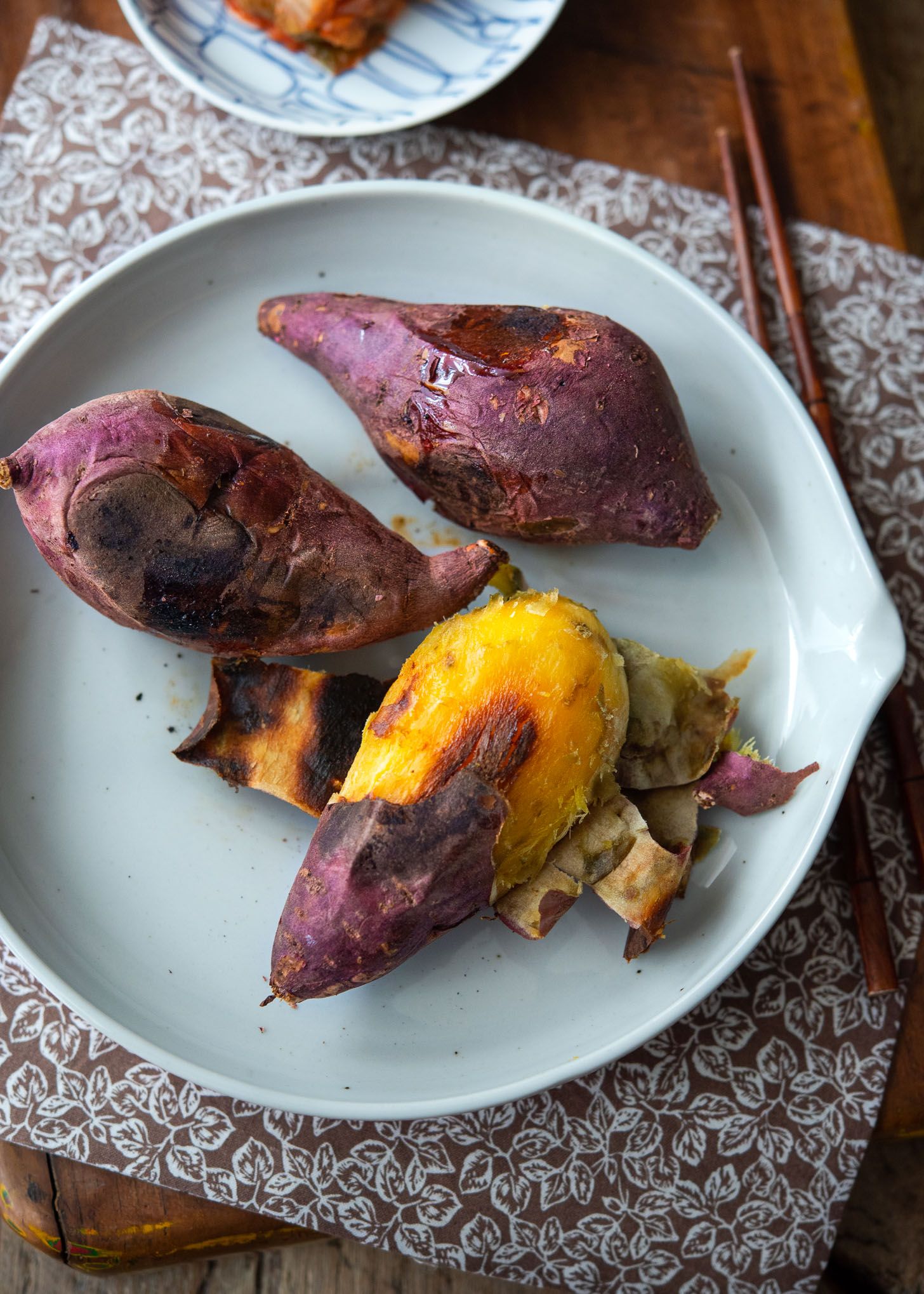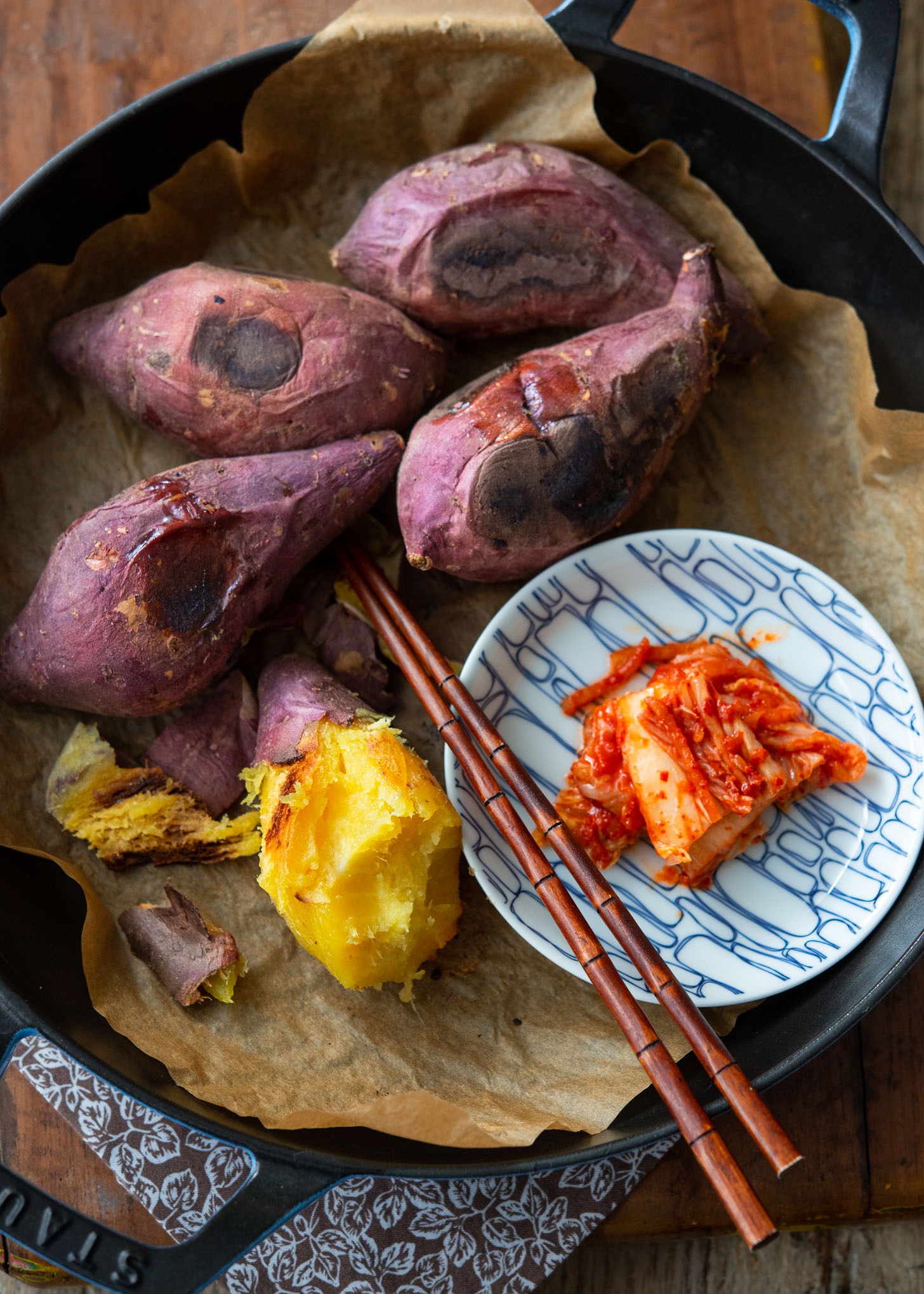Roasted Korean sweet potatoes (gun goguma) are easy to make with this pan-roasting method. Get that perfect charred skin and caramelization, just like the ones from Korean street food vendors.

Korean sweet potatoes, known as goguma (고구마), are a tasty, healthy carb that keeps you full for hours. They’re a favorite snack among Koreans.
When I was growing up in Korea, roasted sweet potatoes (gun-goguma, 군고구마) were my go-to snack, especially in winter. You’ll find street vendors all over Korea roasting them in wood-fired or hot pebble ovens.




Get new recipes via email:
The smell is irresistible, and they’re roasted to perfection—soft and caramelized inside with a crispy, charred skin. While not everyone has access to these special ovens at home, you can still replicate that flavor, texture, and aroma with simple methods!
If you love Korean sweet potatoes, don’t miss out on Mattang (caramelized sweet potatoes)—the deep-fried version with a sticky, sweet glaze. It’s another favorite Korean snack!


Oven-Baked vs. Pan-Roasted
While oven baked Korean sweet potatoes are common, I highly recommend pan roasting instead. Baking in the oven often results in a slightly dry interior and less caramelization.
Pan roasting at a low, steady temperature enhances the natural sweetness of the sweet potato by breaking down starches into sugar. The direct contact with the hot pan helps the natural sugars caramelize, creating thin sugar threads on the skin for that perfect charred look.
All you need is a Dutch oven, heavy-bottom pan, or cast iron skillet with parchment paper. The steam trapped inside keeps the sweet potato flesh moist and honey-like.


Korean Sweet Potatoes vs. American Sweet Potatoes
Korean sweet potatoes have purplish skin with yellow or white flesh that is dense, dry, and starchy, depending on the variety. In contrast, American sweet potatoes have orange flesh with a higher water content. Korean varieties are generally much sweeter in flavor. Both work well for roasting or making desserts.
Varieties of Korean sweet potatoes
- Bam goguma (Chestnut sweet potatoes): These have a reddish-purple skin with white flesh that turns golden yellow when roasted. Named after chestnuts (“bam”), they have a dense, dry texture and a nutty flavor similar to Japanese sweet potatoes.
- Honey Sweet Potatoes (Kkul- Goguma): Recognizable by their deep yellow interior, these sweet potatoes are long, thin, and have reddish-purple skin. They are extremely sweet with a higher moisture content, making them soft and almost creamy when roasted.
- Pumpkin Sweet Potatoes (Hobak-Goguma): These have a juicier texture than chestnut sweet potatoes, with light brown skin and a more orange-colored flesh. When cooked, they become golden brown and develop a creamy texture.
Where to Buy: You can find them at Korean or Asian grocery stores, often labeled as Japanese sweet potatoes, Asian sweet potatoes, or Korean yams. Trader Joe’s and Whole Foods usually carry them in late fall or winter. Choose firm, smooth-skinned potatoes of similar size for even cooking, and avoid overly large ones, as they take longer to roast.
How to pan-roast Korean sweet potatoes
Curing sweet potatoes
It’s best to let sweet potatoes cure before eating. Simply store them at room temperature for 1-2 weeks, placing them on newsprint in a cardboard box. This process converts starches to sugars, making them sweeter and more moist when cooked.
Pan-Roasting


Rinse the sweet potatoes and place them in a braiser or heavy-bottom pan lined with parchment paper in a single layer. Cover with a lid and cook on low heat (or medium-low if needed) for 40-60 minutes, turning every 20 minutes for even roasting.


The sweet potatoes are ready when the skin looks slightly charred and the natural sugars have caramelized. When you lift them, you’ll notice a sticky residue, like thin sugar threads, on the surface.


To test if the sweet potatoes are done, insert a chopstick or toothpick. If it slides in smoothly without resistance, they are ready. Carefully use oven gloves to remove them from the pan and serve hot. Be cautious—they will be very hot!
Serving Suggestion: Sweet Potatoes with Kimchi
In Korea, roasted sweet potatoes are often paired with kimchi. The mix of sweet and savory flavors is incredibly delicious. Give it a try—enjoy!


Love this recipe? Rate it and share your experience in the comments below! On Instagram? Tag me to showcase your creation. For more delicious recipes, subscribe to our newsletter!


Pan Roasted Korean Sweet Potato (Gun-Goguma)
Roasted Korean sweet potatoes (gun goguma) are easy to make with this pan-roasting method. Get that perfect charred skin and caramelization, just like the ones from Korean street food vendors.
- 2 1/4 lb Korean sweet potatoes, See note below
-
Rinse Korean sweet potatoes and place them in a braiser pan or any heavy bottom pan lined with a parchment paper. Make sure your sweet potatoes are placed in a single layer without overlapping.
-
Cover with a lid and place on the stovetop over low heat (if your heat source is not as strong, use medium-low heat); roast for 40-60 minutes depending on their size and thickness. Turn your sweet potatoes every 20 minutes to the other side to roast evenly.
-
The sweet potatoes are done cooking when the skin shows a slightly charred look and the natural sugar is released and caramelized. When lifted, you will see a sticky residue on the surface of the potatoes, in the form of strands of sugar thread.
-
To check for doneness, poke the sweet potato with a chopstick or toothpick. If it goes in very softly without any resistance, they are done. Using oven gloves, remove the sweet potatoes from the pan and serve hot. Be careful! They will be very hot.Serving suggestion: In Korea, these roasted sweet potatoes are often served with kimchi. The combination of sweet and savory is pleasing and very tasty. I recommend that you give it a try. Enjoy!
Curing sweet potatoes: While it’s tempting to consume the purchased sweet potatoes immediately (especially if they are just harvested), I recommend to let them cure first. All you have to do is let them sit at room temperature for 1-2 weeks. Place them on top of newsprint inside a cardboard box, avoiding any additional moisture. During the curing process, the starches inside the sweet potatoes convert to sugars, allowing the sweet potatoes to become sweeter and more moist when cooked.
Calories: 136kcal, Carbohydrates: 31g, Protein: 3g, Fat: 0.2g, Saturated Fat: 0.1g, Polyunsaturated Fat: 0.1g, Monounsaturated Fat: 0.002g, Sodium: 54mg, Potassium: 718mg, Fiber: 5g, Sugar: 10g, Vitamin A: 29057IU, Vitamin C: 30mg, Calcium: 57mg, Iron: 1mg

